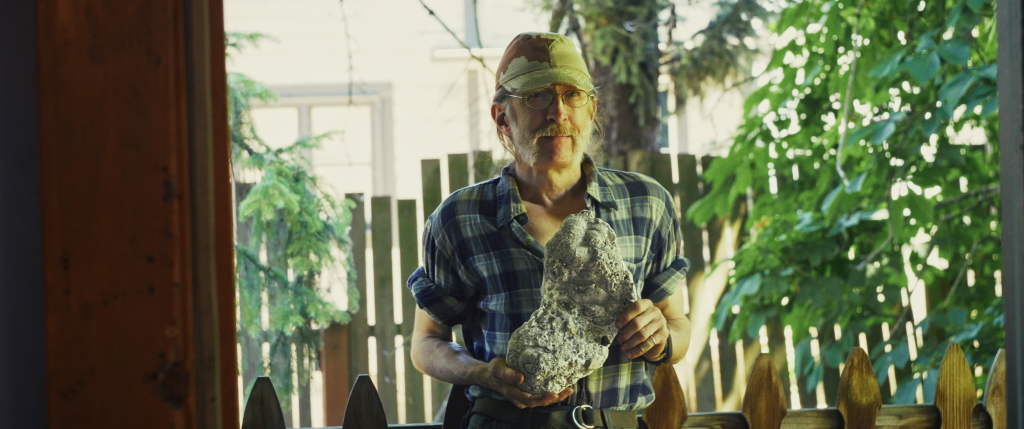Reviews
FROM THE SLAUGHTERHOUSE TO THE FLOPHOUSE?: ‘Texas Chainsaw Massacre’ (2022) Review

Our beloved face-skinning, chainsaw-wielding Bubba is back in a major way, despite the film around him struggling desperately to keep up.
When I first saw the trailer for this film, I predicted a non-stop groan fest with no redeeming qualities. This is not that, but it has as many upsides as it does problems. In short, it’s better than you’d think, but way worse than you’d hope.
Thematically, the film’s backbone is a lot like the spines the Sawyer family cover their furniture with: more decorative than they are substantive. Racism, gentrification, gun control, it’s sprinkled here and there, but all underdeveloped. There’s a line from the side character Catherine where she says people like things worn down, “they want the history,” she claims, but people don’t want the history of a place, flaws and all. It feels like an appropriate metaphor for how the film looks for meaning, but doesn’t take the time to develop that meaning through conversation.
Leatherface Shines: The Big Boy Delivers
But you didn’t come here for social commentary, did you? You want the BIG BOY. Yes, Leatherface is great in this movie; against all the odds, he’s still fun as hell to watch. He doesn’t have the depth that Thomas Hewitt did, or the big heart of the second film’s Bubba Sawyer, but he doesn’t quite need it. His personality boils down to a grieving, mentally stunted man-child, and actor Mark Burnham portrays that and the hulking hillbilly’s physicality PERFECTLY. He’s sloppy, clumsy, prone to bursts of speed and lightning-fast violence, and all in all menacing in his simplicity. Burnham carries the action, works those set pieces, and picks up the slack with kills where the effects falter.
The acting in this ranges from enjoyable to unbearable. Lila is a compelling character, and Elsie Fisher’s performance sells her. On the other hand, despite being whom we follow for most of the runtime, Mel doesn’t have the same depth despite Sarah Yarkin’s fine-tuned ability to portray pure fear. Lila falls to the background until the film’s ACTUAL climax, which is a shame because the fantastic Fisher becomes fantastically underused as a result. And what can you do about the cannon fodder cast? Everybody else is forgettable, unflavored meat for the grinder, which is fine; after all, you can’t make a sausage without chopping up a few yuppies.
The Misstep of Sally Hardesty’s Strode-ification
The Strode-ification of Sally Hardesty, on the other hand, is truly awful. It’s downright silly in a way that is equal parts comedically bad and dramatically insufferable, so you’ll be able to source some laughs from it at least. Olwen Fouéré chews the scenery as she treats this rivalry that popped up 48 minutes ago like a clash 48-years in the making. The subplot is ultimately unnecessary and treats itself way too seriously; the writers should have probably taken a page from Texas Chainsaw Massacre 2‘s book and played her derangement more like Dennis Hopper’s chainsaw crazy Lieutenant Lefty.
The film, in its score, tries to mimic the dark ambient noise of the original, but it doesn’t have nearly as much texture or grit; it’s not scratchy in the richly mixed audio sense of the 1974 soundtrack; it’s just grating industrial noises that scratch your eardrums unpleasantly. Nowhere is this more evident than Richter’s very loud death. They try to evoke the original through this type of sound, but it’s not nearly as impactful since it feels like a failed attempt to cover up some bad sound design. This, combined with some bad CGI for the kill, took a death I would have been impressed by and turns it into a sloppy mess.
Visual Effects and Cinematography: Hit or Miss
Speaking of CGI, the effects in this film oscillate from really good to really bad at an alarming rate. The policemen and Ruth’s murders? Fantastic. Richter’s skull getting caved in? Hideous. Sally finding Mrs. Mc’s with a skinned-off face? Incredible. The bus slaughter? Woof, the over-reliance on CGI blood in that scene is a tragedy. Some parts are just egregiously bad for a film that clearly has good practical effects on hand. The cinematography altogether is nothing to write home about, with truly weird editing choices in the film’s final act, and some camerawork generating a few cool but not super memorable shots.
If there’s one positive note I can close out on, it’s this film’s ending being one of the most insane I’ve seen in a while, feeling like a Texas Chainsaw parody of A Nightmare on Elm Street. It’s a campy, ridiculous set of final frames that I’m kind of in love with for being that bold; I might return to this just for that closer, especially with that corset tight runtime of 73 minutes, not counting credits. If only the rest of the film was that off the wall.
BOTTOMLINE: I have very mixed feelings about this one. It did not commit the cardinal sin of being boring and is very entertaining at certain points, but I can’t in good faith say this is a good movie. It will most definitely generate a split audience. Fans of Leatherface like myself will enjoy his rampage, but not the kind of terrible filmmaking surrounding that carnage. If you turn your brain off, this is a fine watch, but don’t expect anything higher grade than a gory popcorn flick if you’re checking it out this weekend.
Reviews
‘Frankenstein’ Review: Guillermo Del Toro Is Off to the Races

Those expecting Guillermo Del Toro’s Frankenstein to be similar to the book, or to any other adaptation, are in for something else. A longtime enjoyer of the creature’s story, Del Toro instead draws from many places: the novel, James Whale’s culturally defining 1931 film, the Kenneth Branagh version, there are even hints from Terence Fisher’s Curse of Frankenstein, and if the set design and costuming are to be believed, there are trace elements of the National Theatre production too.
The formulation to breathe life into this amalgam is a sort of storm cloud of cultural memory and personal desire for Del Toro. This is about crafting his Frankenstein: the one he wanted to see since he was young, the vision he wanted to stitch together. What results is an experience that is more colorful and kinetic and well-loved by its creator than any Frankenstein we’ve had yet, but what it leaves behind is much of its gothic heart. Quiet darkness, looming dread, poetry, and romance are set aside as what has been sold as “the definitive retelling” goes off to the races. It’s a fast-paced ride through a world of mad science, and you’re on it.
Victor Frankenstein’s Ambition and Tragedy
A tale as old as time, with some changes: the morbid talents and untamed hubris of Victor Frankenstein (Oscar Isaac) guide him to challenge death itself. Spurred by a wealthy investor named Henrich Harlander, and a desire for Harlander’s niece Elizabeth (Mia Goth), Victor uses dead flesh and voltaic vigor to bring a creature to life. His attempts to rear it, however, go horribly wrong, setting the two on a bloody collision course as the definitions of man and monster become blurred.
Guillermo Del Toro’s Frankenstein is more Hellboy in its presentation than it is Crimson Peak; it’s honestly more similar to Coppola’s Dracula than either of them. The film is barely done with its opening when it starts with a loud sequence of the monster attacking Walton’s ship on the ice. Flinging crew members about and walking against volleys of gunfire, he is a monstrosity by no other name. The Creature (Jacob Elordi) cries out in guttural screams, part animal and part man, as it calls for its creator to be returned to him. While visually impressive (and it remains visually impressive throughout, believe me), this appropriately bombastic hook foreshadows a problem with tone and tempo.
A Monster That Moves Too Fast
The pace overall is far too fast for its first half, even with its heavy two-and-a-half-hour runtime. It’s also a far cry from the brooding nature the story usually takes. A scene where Victor demonstrates rudimentary reanimation to his peers and a council of judges is rapid, where it should be agonizingly slow. There’s horror and an instability in Victor to be emphasized in that moment, but the grotesque sight is an oddly triumphant one instead. Most do not revile his experiments; in fact he’s taken quite seriously.
Many scenes like this create a tonal problem that makes Victor’s tale lean more toward melodrama than toward philosophical or emotional aspects; he is blatantly wild and free, in a way that is respected rather than pitied. There are opportunities to stop, breathe in the Victorian roses and the smell of death, to get really dour, but it’s neglected until the film’s second half.
Isaac’s and Goth’s performances are overwrought at points, feeling more like pantomimes of Byronic characters. I’m not entirely convinced it has more to do with them than with the script they’re given. Like Victor working with the parts of inmates and dead soldiers, even the best of actors with the best of on-screen chemistry are forced to make do. The dialogue has incredibly high highs (especially in its final moments), but when it has lows, how low they are; a character outright stating that “Victor is the real monster” adage to his face was an ocean floor piece of writing if there ever was one.
Isaac, Goth, and Elordi Bring Life to the Dead
Jacob Elordi’s work here, however, is blameless. Though Elordi’s physical performance as the creature will surely win praise, his time speaking is the true highlight. It’s almost certainly a definitive portrayal of the character; his voice for Victor’s creation is haunted with scorn and solitude, the same way his flesh is haunted by the marks of his creator’s handiwork. It agonizes me to see so little of the books’ most iconic lines used wholesale here, because they would be absolutely perfect coming from Elordi. Still, he has incredible chemistry with both Isaac and Goth, and for as brief as their time together is, he radiates pure force.
Frankenstein Is a Masterclass in Mise-En-Scène
Despite its pacing and tone issues, one can’t help but appreciate the truly masterful craftsmanship Del Toro has managed to pack into the screen. Every millimeter of the sets is carved to specification, filled with personality through to the shadows. Every piece of brick, hint of frost, stain of blood, and curve of the vine is painstakingly and surgically placed to create one of the most wonderful and spellbinding sets you’ve seen—and then it keeps presenting you with new environments like that, over, and over.
At the very least, Del Toro’s Frankenstein is a masterpiece of mise-en-scène down to the minutest of details, and that makes it endlessly rewatchable for aesthetic purposes. This isn’t even getting into the effervescent lighting, or how returning collaborator Kate Hawley has outdone herself again with the costuming. Guillermo Del Toro tackling the king of gothic horror stories, a story written by the mother of all science fiction, inevitably set a high bar for him to clear. And while it’s not a pitch perfect rendering of Mary Shelley’s slow moving and Shakespearean epistolary, it is still one of the best-looking movies you will see all year.
Perhaps for us, it’s at the cost of adapting the straightforward, dark story we know into something more operatic. It sings the tale like a soprano rather than reciting it like humble prose, and it doesn’t always sing well. But for Del Toro, the epic scale and voice of this adaptation is the wage expected for making the movie he’s always dreamed of. Even with its problems, it’s well worth it to see a visionary director at work on a story they love.
Reviews
‘The Siege of Ape Canyon’ Review: Bigfoot Comes Home

In my home, films like Night of the Demon and Abominable are played on repeat; Stan Gordon is king. One of my favorite stories surrounding Bigfoot and Ufology is the Bigfoot/UFO double flap of 1973, which Stan Gordon has an incredible in-depth book on. The Patterson–Gimlin film couldn’t hold a flame to Stan Gordon’s dive into one of my home state’s most chronicled supernatural time periods. But as much as I love the Bigfoot topic, I’m not ashamed to say I don’t know half of the stories surrounding that big hairy beast. And one topic that I’m not ashamed to say I haven’t heard of is The Siege of Ape Canyon.
The Harrowing Events of Ape Canyon
Washington State, 1924. A group of miners (originally consisting of Marion Smith, Leroy P. Smith, Fred Beck, John Peterson, August Johannson, and Mac Rhodes) was on a quest to claim a potential gold mine. Literally. The miners would eventually set up camp on the east slope of Mount Saint Helens. Little did they know their temporary shelter would be the start of a multi-day barrage of attacks from what they and researchers believed to be Bigfoot. What transpired in those days would turn out to be one of the most highly criticized pieces of American lore, nearly lost to time and history…nearly.
I need to set the record straight on a few things before we get started. One, I don’t typically like watching documentaries. Two, I believe in Bigfoot. Three, this documentary made me cry.

Image courtesy of Justin Cook Public Relations.
Reviving a Forgotten Bigfoot Legend in The Siege of Ape Canyon
Documentarian Eli Watson sets out to tell one of the most prolific Bigfoot stories of all time (for those who are deep in Bigfoot mythology). It’s noted fairly early in the film that this story is told often and is well known in the Washington area. So then, how do people outside of the incident location know so little about it? I’ve read at least 15 books on and about Bigfoot, and I’ve never once heard this story. This isn’t a Stan-Gordon-reported story about someone sitting on the john and seeing a pair of red eyes outside of their bathroom window. The story around Ape Canyon has a deeper spiritual meaning that goes beyond a few sightings here and there.
Watson’s documentary, though, isn’t just about Bigfoot or unearthing the story of Ape Canyon. Ape Canyon nearly became nothing more than a tall tale that elders would share around a campfire to keep the younglings out of the woods at 2 AM. If it weren’t for Mark Myrsell, that’s exactly what would have happened. The Siege of Ape Canyon spends half its time unpacking the story of Fred Beck and his prospecting crew, and the other half tells a truly inspiring tale of unbridled passion, friendship, and love.
Mark Myrsell’s Relentless Pursuit: Friendship, Truth, and Tears
Mark Myrsell’s undying passion for everything outdoors inevitably led to bringing one of Bigfoot’s craziest stories to light. His devotion to the truth vindicated many people who were (probably) labeled kooks and crazies. Throughout Myrsell’s endless search for the truth, he made lifelong friends along the way. What brought me to tears throughout The Siege of Ape Canyon is Watson’s insistence on showing the human side of Myrsell and his friends. They’re not in this to make millions or bag a Bigfoot corpse; they just want to know the truth. And that’s what they find.
The Siege of Ape Canyon is a documentary that will open your eyes to a wildly mystical story you may not have heard of. And it does it pretty damn well. Whereas many documentaries feel the need to talk down to the viewer just to educate them, Watson’s documentary takes you along for the ride. It doesn’t ask you to believe or not believe in Bigfoot. It allows you to make your own decisions and provides the evidence it needs to. If you’ve ever had a passing interest in the topic of Bigfoot, or if you think you’re the next Stan Gordon, I highly recommend watching The Siege of Ape Canyon.
The Siege of Ape Canyon stomps its way onto digital platforms on November 11. Give yourself a little post-Halloween treat and check it out!






















